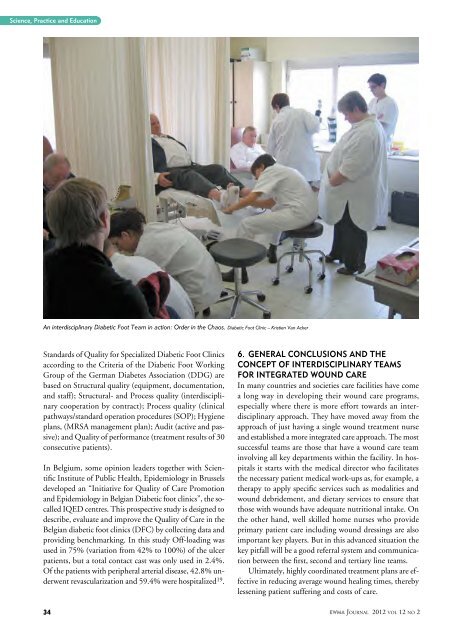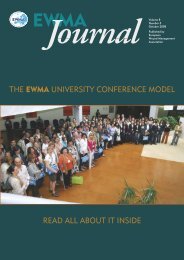Employing interdisciplinary team working to improve patient ... - EWMA
Employing interdisciplinary team working to improve patient ... - EWMA
Employing interdisciplinary team working to improve patient ... - EWMA
You also want an ePaper? Increase the reach of your titles
YUMPU automatically turns print PDFs into web optimized ePapers that Google loves.
Science, Practice and Education<br />
An <strong>interdisciplinary</strong> Diabetic Foot Team in action: Order in the Chaos. Diabetic Foot Clinic – Kristien Van Acker<br />
Standards of Quality for Specialized Diabetic Foot Clinics<br />
according <strong>to</strong> the Criteria of the Diabetic Foot Working<br />
Group of the German Diabetes Association (DDG) are<br />
based on Structural quality (equipment, documentation,<br />
and staff); Structural- and Process quality (<strong>interdisciplinary</strong><br />
cooperation by contract); Process quality (clinical<br />
pathways/standard operation procedures (SOP); Hygiene<br />
plans, (MRSA management plan); Audit (active and passive);<br />
and Quality of performance (treatment results of 30<br />
consecutive <strong>patient</strong>s).<br />
In Belgium, some opinion leaders <strong>to</strong>gether with Scientific<br />
Institute of Public Health, Epidemiology in Brussels<br />
developed an “Initiative for Quality of Care Promotion<br />
and Epidemiology in Belgian Diabetic foot clinics”, the socalled<br />
IQED centres. This prospective study is designed <strong>to</strong><br />
describe, evaluate and <strong>improve</strong> the Quality of Care in the<br />
Belgian diabetic foot clinics (DFC) by collecting data and<br />
providing benchmarking. In this study Off-loading was<br />
used in 75% (variation from 42% <strong>to</strong> 100%) of the ulcer<br />
<strong>patient</strong>s, but a <strong>to</strong>tal contact cast was only used in 2.4%.<br />
Of the <strong>patient</strong>s with peripheral arterial disease, 42.8% underwent<br />
revascularization and 59.4% were hospitalized 19 .<br />
34<br />
6. GENERAL CONCLUSIONS AND THE<br />
CONCEPT OF INTERDISCIPLINARY TEAMS<br />
FOR INTEGRATED WOUND CARE<br />
In many countries and societies care facilities have come<br />
a long way in developing their wound care programs,<br />
especially where there is more effort <strong>to</strong>wards an <strong>interdisciplinary</strong><br />
approach. They have moved away from the<br />
approach of just having a single wound treatment nurse<br />
and established a more integrated care approach. The most<br />
successful <strong>team</strong>s are those that have a wound care <strong>team</strong><br />
involving all key departments within the facility. In hospitals<br />
it starts with the medical direc<strong>to</strong>r who facilitates<br />
the necessary <strong>patient</strong> medical work-ups as, for example, a<br />
therapy <strong>to</strong> apply specific services such as modalities and<br />
wound debridement, and dietary services <strong>to</strong> ensure that<br />
those with wounds have adequate nutritional intake. On<br />
the other hand, well skilled home nurses who provide<br />
primary <strong>patient</strong> care including wound dressings are also<br />
important key players. But in this advanced situation the<br />
key pitfall will be a good referral system and communication<br />
between the first, second and tertiary line <strong>team</strong>s.<br />
Ultimately, highly coordinated treatment plans are effective<br />
in reducing average wound healing times, thereby<br />
lessening <strong>patient</strong> suffering and costs of care.<br />
<strong>EWMA</strong> JOURNAL 2012 VOL 12 NO 2
















